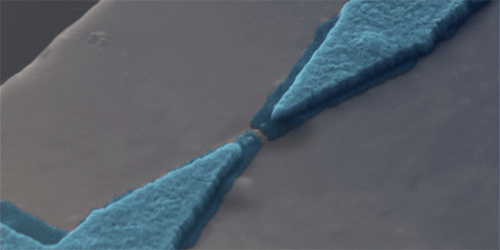May 11, 2016 report
Quantum dot replaces metallic 'island' to improve electronic turnstile

(Phys.org)—A team of researchers with members from France, Russia and Finland has improved on the current design of an electronic turnstile, by replacing the conventional metallic "island" with a quantum dot. In their paper published in Physical Review Letters, the team describes how the design works, why it is better than the conventional approach and how much the error rate was reduced.
Scientists have for some time had a goal of being able to control electric current down to the single electron level, doing so would allow for the development of a whole host of new types of nanoelectronic devices, super small optics and perhaps other types of quantum technologies. Currently, the best approach to achieving this goal is through use of an electronic turnstile—one that only lets one electron through at a time. It is generally created by sandwiching a metallic region between superconducting materials—electrons are then forced to tunnel their way through. Such tunneling is controlled by varying the voltage that arrives via one of the superconducting leads, then out via the second superconducting lead. And while this method has proven to be useful, it does not meet the overall objective, because sometimes an inadvertent electron can sneak through, causing errors. In this new effort, the researchers have replaced the metallic bit with a quantum dot (a semiconducting nanoparticle) to reduce such errors. The thinking was that the dot would be much smaller, allowing only those electrons through that were able to occupy the dot's ground level.
The team reports that they built their new turnstile by taking advantage of tiny fractures that occur in superconducting material when it constricts—gold particles were used to bridge the gaps, the results of which could then serve as quantum dot junctions.
In testing their device, the researchers found that it was able to allow electrons through with just a 1 percent error rate. Furthermore, they report that not only does the junction allow electrons through the turnstile one-by-one, it also allows only those electrons through that have a certain quantum energy level, providing a uniform stream that could be useful in a variety of applications, most especially, the team notes, for use in quantum-metrology applications.
More information: D. M. T. van Zanten et al. Single Quantum Level Electron Turnstile, Physical Review Letters (2016). DOI: 10.1103/PhysRevLett.116.166801 , On Arxiv: arxiv.org/abs/1601.02469
ABSTRACT
We report on the realization of a single-electron source, where current is transported through a single-level quantum dot (Q) tunnel coupled to two superconducting leads (S). When driven with an ac gate voltage, the experiment demonstrates electron turnstile operation. Compared to the more conventional superconductor–normal-metal–superconductor turnstile, our superconductor–quantum-dot–superconductor device presents a number of novel properties, including higher immunity to the unavoidable presence of nonequilibrium quasiparticles in superconducting leads. Moreover, we demonstrate its ability to deliver electrons with a very narrow energy distribution.
Journal information: Physical Review Letters , arXiv
© 2016 Phys.org




















